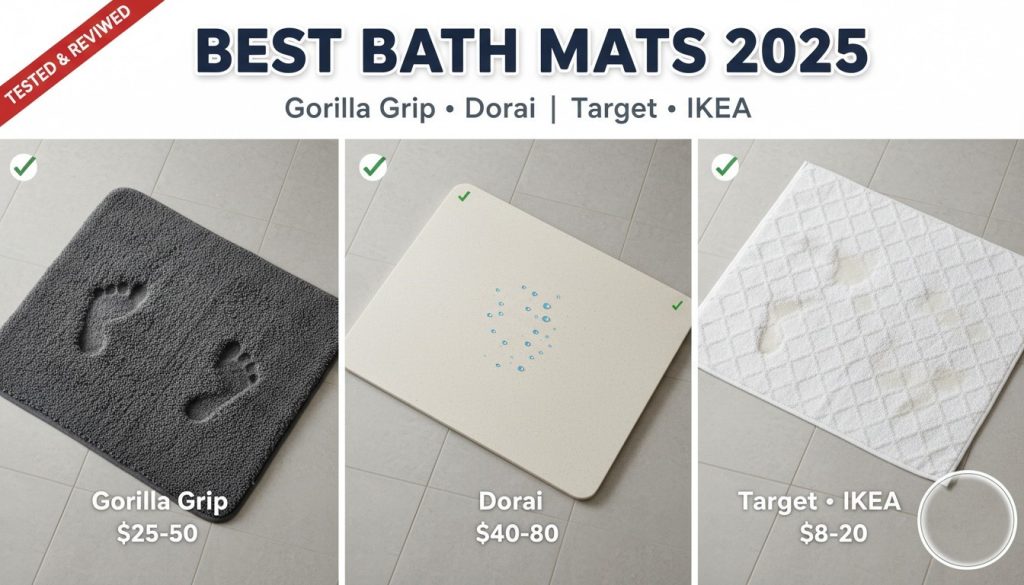
Stepping out of a hot shower onto a cold, slippery floor is nobody’s idea of a good time. I learned this the hard way after moving into my first apartment with those gorgeous (but treacherous) marble-look tiles. One near-slip later, I became obsessed with finding the perfect bath mat—and trust me, I’ve tried more than I care to admit.
What started as a simple shopping trip turned into a full-blown research project. I quickly discovered that not all bath mats are created equal. Some absorb water like a dream but slide around dangerously. Others stay put but never seem to dry properly, developing that musty smell we all dread. The good news? After years of trial and error, I’ve figured out what works and what doesn’t across every price point and brand you can imagine.
Whether you’re furnishing your first bathroom, replacing a worn-out mat, or just tired of dealing with a subpar one, this guide will walk you through everything you need to know. We’ll explore options from budget-friendly finds to premium investments, helping you make a choice you’ll actually be happy with for years to come.
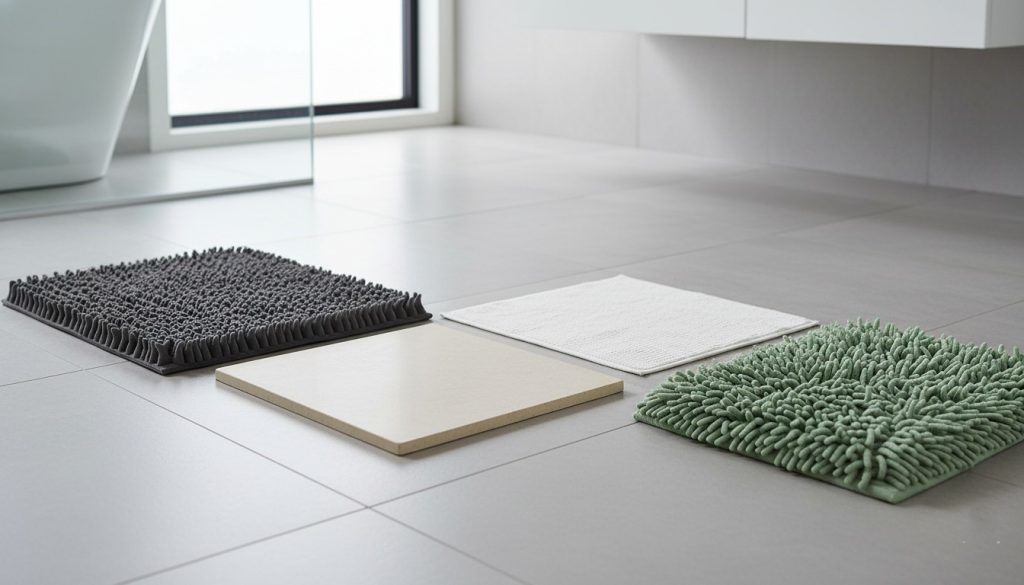
Premium and Specialty Bath Mat Brands
The Stone Revolution: Dorai and Sutera
I’ll admit, when I first heard about stone bath mats, I thought it was a gimmick. Stepping onto a rock after a shower? It sounded uncomfortable at best. But curiosity got the better of me, and I’m genuinely impressed.
Dorai bath mats use diatomaceous earth, which is essentially fossilized algae compressed into a solid surface. I know that sounds weird, but here’s what matters: the stone absorbs water almost instantly. When I step out of the shower, my feet are dry within seconds. No more standing on a soggy mat while I reach for my towel. The surface feels smooth and slightly warm, not cold like I expected.
The antimicrobial properties are a huge bonus too. After six months of daily use, my Dorai mat shows zero signs of mildew or that telltale bathroom smell. I simply wipe it down once a week with a damp cloth, and it looks brand new. The biggest downside? The price tag hovers around $80-$100, and these mats are fragile—drop one, and you might be shopping for a replacement.

Sutera bath mats work on the same principle but often come in slightly different designs and color options. I borrowed my sister’s for a week when she went on vacation, and honestly, the performance is nearly identical to Dorai. Both dry almost instantly and stay fresh without any special treatment. The choice between them often comes down to which design you prefer and which happens to be on sale.
These stone mats work best if you have good ventilation in your bathroom and you’re careful about not knocking them over. They’re also perfect for people with allergies or sensitivities to mold, since they literally don’t give mildew a chance to grow.
The Non-Slip Champion: Gorilla Grip
If there’s one brand that consistently delivers on the promise of staying put, it’s Gorilla Grip bath mats. I’ve used three different styles from this brand over the years, and each one has lived up to its reputation.
The secret is in the backing. Unlike cheaper mats that use a few rubber dots or strips, Gorilla Grip covers the entire underside with a thick, grippy material that genuinely doesn’t budge. I’ve tested this on tile, vinyl, and even smooth concrete in a rental bathroom, and the mat stayed firmly in place every single time. This is especially important in my household because my elderly mother visits regularly, and I need to know she’s safe stepping out of the shower.
The brand offers several material options. The memory foam version is my personal favorite—it’s thick, plush, and feels luxurious under bare feet. The chenille style dries faster and works better in a humid bathroom. I’ve also tried their microfiber option, which strikes a nice balance between absorbency and quick drying.
All Gorilla Grip mats are machine washable, which is a game-changer. I toss mine in the washing machine every two weeks with my towels, and it comes out looking fresh. The colors haven’t faded, and the backing is still as grippy as day one even after dozens of washes. Price-wise, you’re looking at $20-$35 depending on size and style, which feels reasonable for the quality and longevity you get.
The only real complaint I have is that the thicker memory foam versions take a while to dry completely after washing. I usually hang mine over the shower rod overnight before putting it back on the floor.
Big Box Retailer Favorites
Target and Walmart: More Than Just Convenience
I used to be a bath mat snob, thinking I needed to shop at specialty stores for anything decent. Then I actually paid attention to what Target and Walmart were offering, and I was pleasantly surprised.
Target’s Made By Design line has become my go-to for guest bathrooms. These mats look way more expensive than they are, with clean, modern designs that fit into almost any decor scheme. The quality is solid for the $15-$25 price range. I particularly love their quick-dry options, which use a waffle-weave texture that prevents water from pooling. Room Essentials, Target’s budget brand, works fine for a basic mat, though I’ve found they start looking worn after about six months of daily use.
Walmart’s offerings surprised me even more. The Better Homes & Gardens collection includes some genuinely plush, spa-like mats that rival more expensive brands. I picked up one for my main bathroom on a whim, and two years later, it still looks great. The Mainstays brand is perfect if you need something simple and functional without breaking the bank—think college apartments or rental properties.
Both retailers switch up their designs seasonally, which is fun if you like refreshing your bathroom decor. I’ve learned to stock up on neutrals when I find ones I like because specific colors and patterns don’t always come back. The return policies at both stores are also incredibly forgiving, so if a mat doesn’t work out, you’re not stuck with it.
One practical tip: check the thread count and weight when shopping at these stores. Heavier mats with higher thread counts tend to be more absorbent and durable, even within the same brand line.
Costco: Bulk Buying Benefits
I resisted getting a Costco membership for years, but my neighbor finally convinced me, and the bath mat selection alone almost justifies the annual fee. Almost.
Costco bath mats typically come in multipacks, which initially seemed excessive until I realized I could outfit my entire house for less than buying individual mats elsewhere. Last year, I picked up a four-pack of Charisma brand bath mats for around $50. These are genuinely nice mats—thick, absorbent, with a dense pile that feels luxurious. Buying them individually at a department store would easily cost $30-$40 each.
The quality of brands available at Costco fluctuates, but they tend to stock well-known names at significant discounts. I’ve seen premium brands like Kassatex and Croscill appear periodically. The key is to check regularly because inventory changes, and good deals don’t last long.
Costco’s return policy is another huge advantage. When I bought a set that looked perfect online but turned out to be too thin in person, I returned them three weeks later with zero hassle. This takes the risk out of trying something new.
The downside? Selection is limited compared to traditional retailers, and you can’t always find exactly what you want when you need it. If you’re particular about matching a specific color scheme, you might need to look elsewhere. But for general household use or stocking rental properties, Costco is hard to beat.

Affordable European Design: IKEA
IKEA deserves its own section because the approach here is completely different from traditional retailers. The Scandinavian design philosophy emphasizes simplicity and function over frills, and you’ll see this reflected in every bath mat they offer.
I’ve owned IKEA bath mats in three different apartments, and they’ve always served me well. The TOFTBO series is my personal favorite—it’s a simple microfiber mat that absorbs water efficiently and dries quickly. At around $7-$12 depending on size, it’s almost disposable, which makes it perfect for renters or anyone who likes to switch up their decor frequently.
The BORRIS mat, made from chenille, offers a slightly more upscale feel while still staying budget-friendly. I used one in a tiny bathroom where space was tight, and the smaller size options IKEA offers worked perfectly. The STOCKARYD is their plushest option, with a higher pile that feels great underfoot but takes longer to dry.
IKEA has also been pushing sustainable materials more aggressively than most competitors. Several of their bath mats now include recycled polyester, which appeals to my environmentally conscious side without sacrificing performance. The mats wash well and hold their shape even after multiple cycles.
The biggest challenge with IKEA is actually getting to a store if you don’t live near one. Their online shipping can be expensive for individual items, so it’s worth planning a trip if you need other household items too. I usually grab a couple of extra mats when I’m there because at these prices, it makes sense to have backups.
One thing I’ve learned: IKEA mats work best in moderate-traffic bathrooms. In my main bathroom with heavy daily use, they start looking tired after about a year. But for guest bathrooms or powder rooms, they last much longer and remain an incredible value.
Trusted Household Brands
Rubbermaid: Function Over Fashion
When I think Rubbermaid, I think of storage bins and kitchen organizers—not exactly glamorous. But their bath mats bring that same practical, no-nonsense quality to the bathroom, and sometimes that’s exactly what you need.
I first tried a Rubbermaid mat out of desperation when my previous one literally fell apart in the washing machine. I grabbed one at the hardware store without high expectations, and I was impressed by how well it performed. These mats aren’t trying to win design awards, but they’re built to last and genuinely work.
Rubbermaid offers both in-tub mats with suction cups and traditional floor mats. I use their textured tub mat in my shower because the suction cups actually stay attached (unlike cheaper versions that constantly pop off). The texture provides real grip without being uncomfortable on bare feet. After two years, the suction cups still hold strong, and the mat hasn’t developed any mildew issues.
Their floor mats have a commercial-grade feel to them—thick, durable, with straightforward designs in basic colors. This might sound boring, but it means they coordinate with everything and hold up to serious wear. I put one in my laundry room bathroom, which gets used by muddy kids coming in from the backyard, and it handles the abuse without complaint.
The best part? Rubbermaid mats are ridiculously easy to clean. I spray mine down in the shower once a week, and it dries quickly without holding odors. The price point is reasonable too, usually $15-$25, which feels appropriate for what you’re getting.
These aren’t luxury mats by any stretch. If you’re designing an Instagram-worthy bathroom, you might want something more aesthetically pleasing. But if you need a reliable, long-lasting mat that does its job without fuss, Rubbermaid delivers.
Haven: Accessible Luxury
Haven bath mats occupy an interesting middle ground—they look and feel premium without the premium price tag. I discovered them while shopping at a home goods store, and they’ve become a favorite for main bathrooms where I want something nice but not precious.
The material composition is what impressed me first. Haven uses a high-quality cotton blend that feels genuinely plush and substantial. When you step out of the shower, it’s soft and cushioned, similar to what you’d experience at a nice hotel. The thickness is just right—absorbent enough to soak up water effectively but not so thick that it takes forever to dry.
Color options are Haven’s strong suit. I’ve seen everything from classic whites and neutrals to bold jewel tones and subtle heathered blends. The colors stay true even after repeated washings, which hasn’t been my experience with some other brands in this price range.
At around $20-$40 depending on size, Haven mats occupy that sweet spot where you’re getting excellent quality without feeling like you’re splurging. I bought one for my primary bathroom three years ago, and despite near-daily use and regular washing, it still looks respectable. The edges haven’t frayed, the pile hasn’t gotten matted down, and the backing still provides adequate grip.
The one area where Haven doesn’t excel is innovation. These are traditional fabric bath mats done well, but there’s nothing revolutionary about them. You won’t get the instant-dry properties of stone mats or the aggressive non-slip backing of Gorilla Grip. What you get is a solid, reliable, attractive mat that performs consistently.
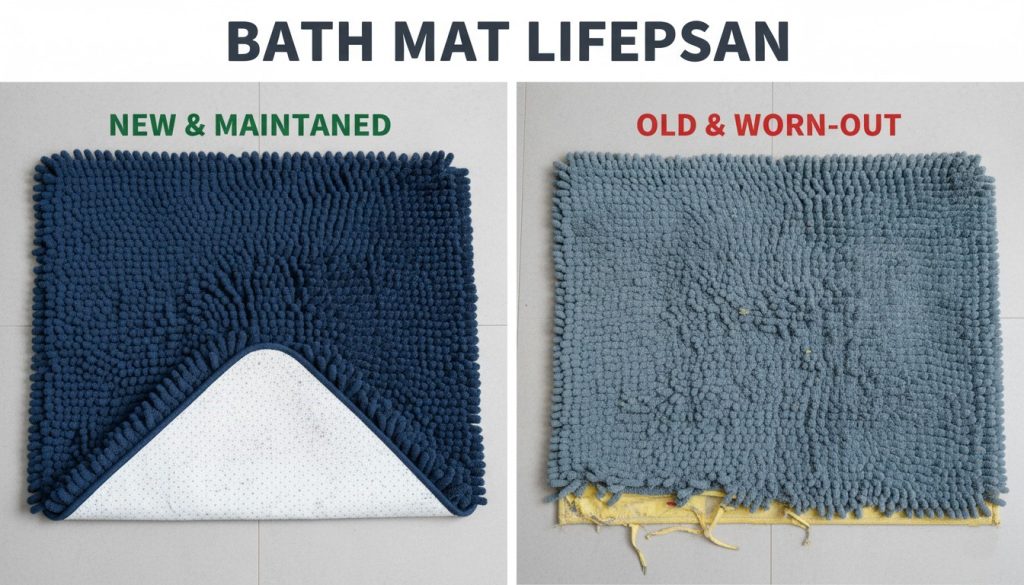
Making the Right Choice: Matching Bath Mats to Your Needs
After living with more bath mats than any reasonable person should own, I’ve developed a pretty clear framework for choosing the right one based on specific circumstances. Let me share what I’ve learned through trial and error—hopefully saving you some of the mistakes I made along the way.
Budget Considerations: When to Splurge and When to Save
My main bathroom gets used constantly. I shower there every morning, my partner showers there every evening, and guests use it during parties. This is where I invest in quality. My Gorilla Grip memory foam mat cost $30, but three years later, it’s still performing like new. Divide that cost by three years of daily use, and it’s actually cheaper than buying a $10 mat that needs replacing every six months.
Guest bathrooms are different. That bathroom gets used maybe twice a month when people visit. Here, I use an IKEA TOFTBO that cost $8. It looks presentable, works fine for occasional use, and if I want to change the color scheme, I’m not throwing away a significant investment.
The stone mats from Dorai and Sutera occupy a special category. At $80-$100, they’re expensive upfront, but they literally never need replacing unless you break them. If you have chronic issues with mildew, struggle with mobility, or just hate dealing with wet fabric mats, the investment makes sense. I use mine in a basement bathroom with ventilation issues, and it’s solved problems that no fabric mat could address.
For rentals or temporary living situations, stick with the $15-$25 range from Target, Walmart, or Costco. You’ll get decent performance without investing heavily in a space you might leave soon.
Bathroom Size and Layout Factors
Small bathrooms present unique challenges. My powder room is barely five feet square, and fitting a standard bath mat made the space feel cramped. I switched to a smaller IKEA mat, and it made a surprising difference in how spacious the room feels. Don’t automatically buy the largest size—measure your space and visualize how much floor the mat will cover.
If you have a particularly large bathroom, consider using two mats: one at the shower and another at the sink. I do this in my primary bathroom, and it keeps water contained much better than trying to use a single oversized mat. The sink mat can be thinner and more decorative since it’s not dealing with post-shower water levels.
Doorway clearance is something I learned about the hard way. Thick, plush mats sometimes prevent doors from opening fully. Before I figured this out, I struggled with my bathroom door catching on my beautiful new memory foam mat every single time I opened it. Measure the clearance under your door, especially if it opens inward, and choose mat thickness accordingly.
Household Composition Matters
Having elderly parents visit regularly completely changed my mat priorities. Safety became paramount. I now exclusively use mats with serious non-slip backing in bathrooms my mother uses. The Gorilla Grip line has literally prevented falls—I’ve seen my mom step out of the shower slightly off-balance, and the mat doesn’t move even a millimeter.
With kids, washability trumps almost everything else. Children somehow manage to get bath mats incredibly dirty in ways I can’t even explain. I’ve learned to buy mats that can handle frequent hot water washing without falling apart. The Haven and Gorilla Grip options both survive this abuse well. The stone mats are also great with kids since they can’t get “dirty” in the traditional sense—you just wipe them down.
Pet owners need to think about fur and scratching. My friend’s cat treats bath mats like scratching posts, so she needs extremely durable materials. The Rubbermaid mats have held up best for her. Also consider how much pet hair will show up on the mat—darker colors or patterns hide this better than pristine white.
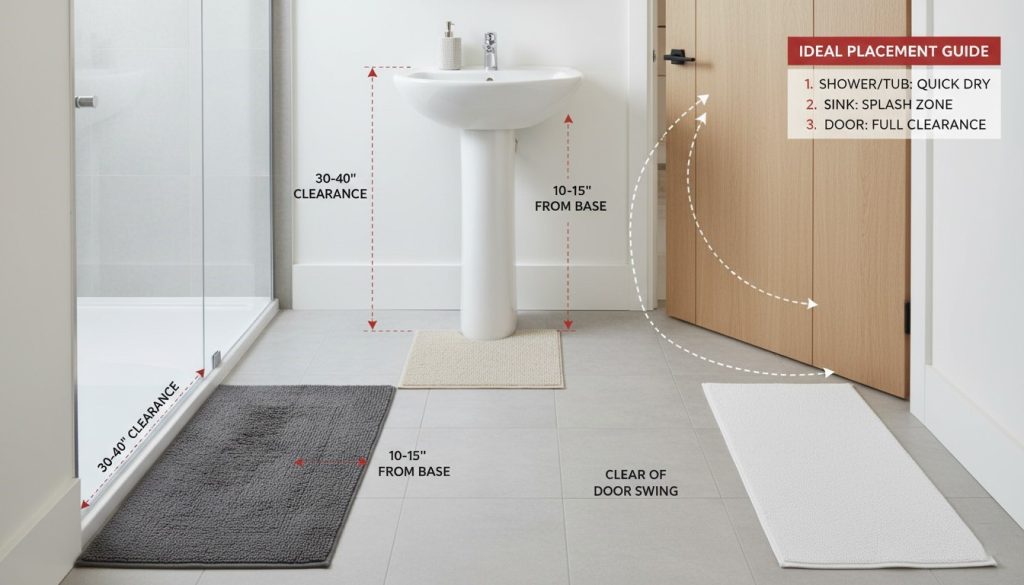
Climate and Humidity Considerations
I grew up in the Pacific Northwest where bathrooms never fully dry out, and now I live in a dry climate. This change taught me that environment dramatically affects which mats work best.
In humid areas, quick-drying materials are essential. Stone mats are ideal here, but if you prefer fabric, look for waffle-weave or microfiber options that don’t hold moisture. My chenille Gorilla Grip mat works better in humid climates than the memory foam version, which stays damp longer. If you live somewhere muggy, wash your mats more frequently—at least weekly—to prevent mildew.
Dry climates are more forgiving. Thicker, plusher mats work fine because they actually dry out between uses. I use my luxurious Haven mat without worrying about moisture issues. However, static electricity becomes a concern in very dry areas. I’ve gotten shocked a few times touching metal fixtures after walking across certain synthetic mats in winter.
Radiant floor heating changes everything. If you have heated bathroom floors, thick rubber-backed mats can interfere with heat transfer or even get damaged by sustained heat exposure. Stone mats work perfectly here since they’re not affected by heat, and thinner cotton mats without heavy rubber backing also perform well.
Style and Decor Matching
I used to think this didn’t matter much—it’s just a bath mat, right? But I’ve come to appreciate how much a well-chosen mat can enhance a bathroom’s overall feel.
Minimalist, modern bathrooms benefit from clean-lined stone mats or simple solid colors from the IKEA range. I recently redesigned my main bathroom in a minimalist style, and switching from a busy patterned mat to a simple gray Dorai mat made the whole room feel more cohesive and intentional.
Traditional or farmhouse-style bathrooms look great with textured, cozy mats. The chunky chenille options from Gorilla Grip or the plush Haven mats in warm neutrals complement this aesthetic perfectly. My parents have a classic farmhouse bathroom, and the thick, ivory Haven mat I gave them fits the space beautifully.
If you like changing decor seasonally, invest in one high-quality neutral mat for everyday use and supplement with inexpensive IKEA or Target mats in seasonal colors. I keep a white Gorilla Grip mat as my base but swap in a coral version in summer and a deep burgundy for fall. It satisfies my urge to redecorate without breaking the bank.
Care and Maintenance: Making Your Mat Last
I’ve killed more bath mats through poor care than through actual wear and tear. Learning proper maintenance has dramatically extended the life of my current collection.
Washing Frequency and Methods
Most fabric mats need washing every one to two weeks depending on use. I wash my main bathroom mat weekly because it sees constant traffic. Guest bathroom mats can go longer between washes, sometimes a month if they’re barely used.
Always shake out your mat before washing to remove loose debris and hair. I learned this after clogging my washing machine’s lint trap more times than I care to admit. For heavily soiled mats, I do a quick rinse in the bathtub first, stomping on them like I’m making wine to release ground-in dirt.
Machine washing works for most mats, but check the label. I wash mine on a gentle cycle with warm (not hot) water and skip the fabric softener, which can reduce absorbency. Adding white vinegar to the rinse cycle helps remove any detergent residue and keeps mats fresh.
The rubber backing on non-slip mats requires special attention. High heat can break down the material, making it crumbly and ineffective. I always air dry mats with rubber backing or use the lowest heat setting on the dryer. My Gorilla Grip mats have lasted years longer because I follow this rule.
Stone mats require almost no maintenance. I wipe mine with a damp cloth once a week and occasionally use a gentle cleanser if it looks dingy. Every few months, I sand the surface lightly with fine-grit sandpaper to refresh the absorbency, which takes maybe five minutes.
Drying Methods That Extend Lifespan
Air drying is always gentler and better for longevity. I hang mats over my shower rod or outdoor clothesline whenever possible. They might take a day to fully dry, which is why having backup mats makes sense.
If you must use a dryer, low heat is crucial. I typically start the dryer for 20-30 minutes, then pull the mat out while it’s still slightly damp and let it finish air drying. This speeds up the process without exposing the mat to prolonged heat.
Never leave a wet mat bunched up or folded. I made this mistake early on, leaving a damp mat in the washing machine overnight, and it developed such a terrible mildew smell that I had to throw it away. Spread mats out immediately after washing, even if you’re just laying them flat on the floor temporarily.
In humid climates, I’ve learned to dry mats in the sun whenever possible. UV light naturally kills mold and bacteria while helping mats dry faster. My balcony has become a regular mat-drying station during summer months.
Dealing With Mold and Mildew
Despite best efforts, sometimes mats develop that musty smell or visible mildew spots. I’ve successfully rescued several mats that seemed destined for the trash.
Vinegar is my first line of defense. I soak affected mats in a bathtub with hot water and two cups of white vinegar for about 30 minutes, then wash as normal. This has eliminated odors and light mildew many times. For stubborn cases, I add a half cup of baking soda to the washing machine along with regular detergent.
Hydrogen peroxide works on visible mildew stains. I spray it directly on affected areas, let it sit for 10-15 minutes, then wash immediately. This has saved a few light-colored mats that developed black spots.
Prevention is easier than cure. Make sure your bathroom has adequate ventilation—run the exhaust fan during showers and for at least 15 minutes after. Hang your mat over the tub or shower door occasionally to let both sides dry completely. I do this once or twice a week, and it makes a noticeable difference in keeping mats fresh.
When to Replace Your Bath Mat
Even the best-maintained mat eventually needs replacing. I look for several warning signs.
Visible wear on the backing is a critical safety issue. If the non-slip material is cracking, peeling, or has worn smooth, the mat is no longer preventing slips effectively. Replace it immediately, especially if elderly people or children use that bathroom.
Persistent odors that don’t respond to vinegar or other treatments mean bacteria have penetrated too deeply into the material. I’ve tried to salvage mats at this stage, and it’s never worth the effort. Just replace it.
Thinning pile or matted-down fibers indicate the mat has reached the end of its useful life. It might still be absorbent, but it won’t be as comfortable or effective. When my mats reach this point, I demote them to less-important bathrooms or use them as garage mats before recycling.
Fraying edges or tears don’t necessarily mean the mat is done. I’ve successfully trimmed frayed edges to extend a mat’s life by several months. But once the fraying becomes extensive or the mat develops holes, it’s time to shop for a replacement.
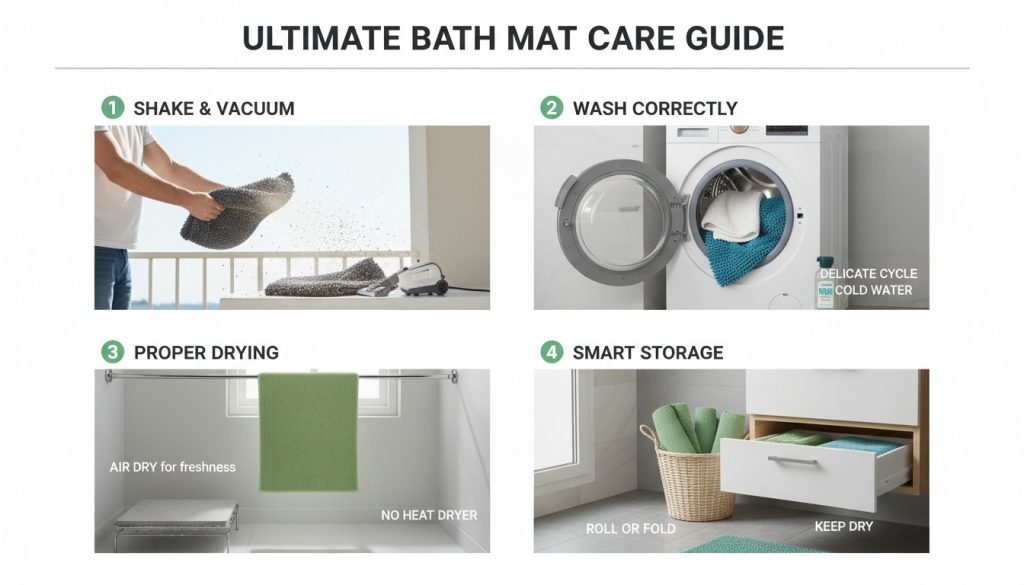
Frequently Asked Questions
What’s the best bath mat for preventing slips?
Based on my personal experience across multiple homes and floor types, Gorilla Grip mats offer the most reliable slip resistance. The entire backing surface is covered with grippy material, not just a few strategic dots. I’ve tested these on wet tile, vinyl, and sealed concrete, and they simply don’t move. For even more security, stone mats like Dorai provide grip through their slightly textured surface and substantial weight. They’re especially good for people with mobility concerns since there’s zero chance of the mat sliding out from under you.
How often should I replace my bath mat?
This depends entirely on quality and usage. My cheap $10 mats typically last six months to a year before looking worn. Mid-range options from Haven or Gorilla Grip usually give me two to three years of daily use. Higher-end mats can last even longer with proper care. Stone mats theoretically last indefinitely unless dropped. I gauge replacement by visible wear, persistent odors, or compromised non-slip backing rather than following a strict timeline.
Are stone bath mats worth the investment?
For certain situations, absolutely. I use mine in a basement bathroom with humidity issues, and it’s completely eliminated the mildew problems I battled with fabric mats. The instant-dry surface is genuinely impressive, and the zero-maintenance aspect appeals to my lazy side. However, at $80-$100, they’re not for everyone. If you have kids who might drop things on them, pets who might knock them over, or you’re renting and moving frequently, stick with fabric options. But if you have allergies, hate washing mats, or live in a humid climate, stone mats solve real problems.
Can all bath mats go in the washing machine?
Most fabric mats can, but always check the care label first. I’ve learned this lesson expensively. Rubber-backed mats need cool or warm water, never hot, and should air dry or use low heat to prevent the backing from deteriorating. Some decorative mats with embellishments might require hand washing. Stone mats obviously don’t go in the washing machine—just wipe them with a damp cloth. When in doubt, hand wash in the bathtub first to see how the mat responds before risking your washing machine.
What size bath mat do I need?
Measure the space in front of your shower or tub before shopping. I typically recommend mats that are at least 20 by 30 inches for standard shower areas, giving you enough room to step out comfortably without missing the mat entirely. For bathtubs, longer mats (like 24 by 60 inches) work better to accommodate the full length. Remember to account for door swing—I’ve made the mistake of buying mats too thick for my door clearance. In small bathrooms, sometimes a smaller mat looks more proportional and doesn’t overwhelm the space.
Where can I find the best deals on quality bath mats?
Timing matters more than most people realize. I’ve gotten my best deals on quality mats at Costco during their periodic home goods rotations, scoring premium brands at significant discounts. Target’s seasonal clearances, especially in January and July, offer excellent deals on their Made By Design line. Walmart surprisingly has competitive pricing year-round on their Better Homes & Gardens collection. For stone mats, wait for holiday sales—I saved $20 on my Dorai mat during a Black Friday sale. IKEA maintains consistent low prices, so you don’t need to wait for sales there. Sign up for email lists from your favorite brands; I regularly get 20% off coupons from retailers that make higher-end options more accessible.
Finding Your Perfect Match
After years of slipping, tripping, and dealing with musty bathroom smells, I’ve finally figured out this whole bath mat thing. The perfect mat for you depends on your specific circumstances—your bathroom setup, your household, your budget, and honestly, how much effort you want to put into maintenance.
For everyday reliability in busy households, I keep coming back to Gorilla Grip. The combination of comfort, safety, and durability justifies the modest price increase over budget options. When I’m shopping for someone else or need to outfit multiple bathrooms inexpensively, Target’s Made By Design line offers surprising quality for the price.
Stone mats from Dorai and Sutera have earned their place in specific situations where fabric mats consistently fail. Yes, they’re expensive, but if you’ve ever dealt with chronic bathroom humidity or mildew issues, you understand the value of a solution that actually works.
The lesson I’ve learned through all this trial and error is simple: there’s no single “best” bath mat. There’s only the best mat for your particular situation. A mat that works perfectly in my spacious, well-ventilated main bathroom might be completely wrong for a tiny, humid guest bathroom. The mat that keeps my elderly mother safe might be overkill for a college student’s apartment.
Start by identifying your priority: Is it safety? Budget? Low maintenance? Aesthetics? Once you know what matters most to you, the choice becomes much clearer. And remember, bath mats aren’t heirloom pieces. If something doesn’t work out, try something different. I’ve probably bought 20 different mats over the years, and each “mistake” taught me something that ultimately led to finding combinations that work perfectly for different spaces in my home.
Your feet deserve better than a soggy, slippery mat that smells like mildew. Take the time to find something that actually works, and your morning shower routine will be just a little bit better every single day.
Leave a Reply